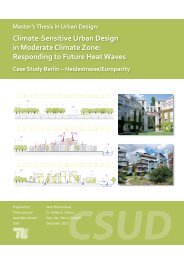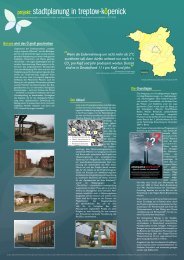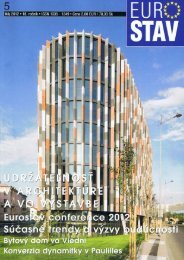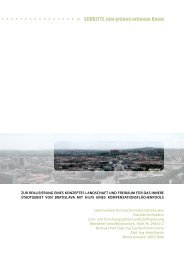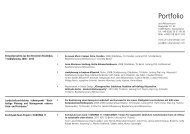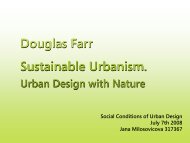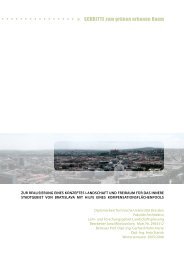Bausteine - Referate - Jana Milosovicova - Urban Design English
Bausteine - Referate - Jana Milosovicova - Urban Design English
Bausteine - Referate - Jana Milosovicova - Urban Design English
Sie wollen auch ein ePaper? Erhöhen Sie die Reichweite Ihrer Titel.
YUMPU macht aus Druck-PDFs automatisch weboptimierte ePaper, die Google liebt.
Sustainable neighborhood rating systems: An international comparison<br />
Die Bewertungsmatrix<br />
In this evaluation, the criteria for earning LEED-<br />
ND points are compared and contrasted with<br />
the criteria that receive the best to worst grade<br />
by the Assessment Matrix. Some heavily weighted<br />
criteria will also be noted for credits over<br />
two points in LEED-ND and above six percent<br />
in the Assessment Matrix. (For a complete comparison<br />
of all credits, see Appendix 1)<br />
1. Location and Previous Use<br />
regarding previous site use is if the site is a<br />
brownfield. Brownfield credits address remediation,<br />
their redevelopment in low-income areas,<br />
and extensive cleanup of brownfield soil. The<br />
Assessment Matrix goes into detail rating the<br />
previous use of the site, using a gradation of<br />
over 20 different site uses. This rating, with a 14<br />
percent weight, gives the best score for using<br />
completely built-up locations with impervious<br />
surface and the worst score to using forests or<br />
protected natural areas.<br />
The Location and Previous Use category focuses<br />
on the where the project is located in relation<br />
to the surrounding area and the degree of<br />
prior development. The goal is to previously developed<br />
sites in relatively central locations with<br />
transit and services nearby. Discouraged is the<br />
use of greenfield sites in remote locations.<br />
Site Location<br />
Both rating systems address project location:<br />
LEED-ND favors urban infill sites with infrastructure<br />
and some services while the Assessment<br />
Matrix prioritizes proximity to a neighborhood<br />
center. In LEED-ND, the minimum requirement<br />
for a greenfield site is either adequate transit<br />
service, some diverse uses nearby or low vehicle<br />
miles traveled. Up to 10 additional points<br />
for site location are based on whether the site<br />
was previously developed, the amount of adjacent<br />
development surrounding the site, and the<br />
“urbanness” of the site as measured by street<br />
centerline density in the mile radius around<br />
the project. In contrast, the Assessment Matrix<br />
considers the plan location to be a mobility issue<br />
and ranks locations by time-distance to a<br />
neighborhood center when traveling by transit<br />
or bicycle, with an overall 9 percent weight for<br />
this criteria.<br />
Previous Site Use<br />
In LEED-ND, aside from categorizing a site<br />
as “previously developed” or “not previously<br />
developed,” the only additional consideration<br />
Infrastructure Provision<br />
Unique to LEED-ND is a prerequisite for locating<br />
a development where water and sewer<br />
infrastructure are located or planned to be located.<br />
This prevents a common practice in lowdensity<br />
areas where individual wells and septic<br />
systems are installed. The use of septic systems<br />
can pose health problems a failure allows sewage<br />
to enter underground water resources.<br />
2. Transportation and Reachability<br />
This category, Transportation and Reachability,<br />
reflects the relationship between transportation<br />
and the access it provides to different destinations.<br />
The first part includes the primary<br />
modes of eco-mobility that are encouraged:<br />
transit and bicycling (walking is considered in<br />
the next category) as well as the reduction of<br />
automobile travel. The second part, the concept<br />
of “reachability,” evaluates the quality of a location<br />
based on the time-distance by eco-mobility<br />
to common destinations such as jobs, shops,<br />
schools or parks. The concept of reachabilty is<br />
central to the Assessment Matrix; however in<br />
LEED-ND only the bicycle network and jobs<br />
and housing balance credits consider the destination<br />
and transportation together.<br />
Common destinations are measured by both<br />
systems; however the Assessment Matrix takes<br />
a more nuanced view toward types of destinations<br />
and their respective locations. LEED-ND<br />
has one category of “diverse uses” to measure<br />
104



